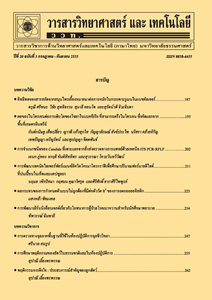การประเมินแนวปฏิบัติในการประเมินภาวะตัวเหลืองในทารกแรกเกิดที่โรงพยาบาลคลองหลวง จังหวัดปทุมธานี
Main Article Content
Abstract
บทคัดย่อ
ภาวะตัวเหลืองเป็นปัญหาที่พบบ่อยในทารกแรกเกิด และจำเป็นต้องได้รับการวินิจฉัยอย่างรวดเร็ว เพื่อหลีกเลี่ยงไม่ให้สมองถูกทำลายอย่างถาวร โรงพยาบาลคลองหลวงได้ปรับแนวปฏิบัติในการเฝ้าระวังและวินิจฉัยภาวะตัวเหลืองในทารกแรกเกิด และได้นำมาใช้ตั้งแต่เดือนตุลาคม พ.ศ. 2556 การศึกษานี้มีวัตถุประสงค์เพื่อสำรวจหาปัจจัยเสี่ยงของภาวะตัวเหลืองในทารกแรกเกิด และประเมินแนวปฏิบัติใหม่ที่นำมาใช้ โดยศึกษาในทารกแรกเกิดที่คลอดระหว่างเดือนตุลาคม พ.ศ. 2556 ถึงเดือนกุมภาพันธ์ พ.ศ. 2557 จำนวน 100 ราย (ชาย 53 ราย และหญิง 47 ราย) พบว่าทุกรายมีภาวะตัวเหลือง (ค่าไมโครบิลิรูบิน > 5 มิลลิกรัม/เดซิลิตร) ซึ่งเป็นภาวะตัวเหลืองผิดปกติร้อยละ 25 ส่วนใหญ่ไม่ทราบสาเหตุของภาวะตัวเหลือง คิดเป็นร้อยละ 50 ส่วนที่ทราบสาเหตุ คือ หมู่เลือดของมารดาและลูกไม่เข้ากัน และภาวะเม็ดเลือดแดงแตกมากกว่าปกติ ซึ่งพบร้อยละ 10 และ 9 ตามลำดับ การนำแนวปฏิบัติใหม่มาใช้ช่วยให้สามารถระบุสาเหตุของภาวะตัวเหลืองในทารกแรกเกิดได้เพิ่มมากขึ้น โดยภาวะตัวเหลืองที่ไม่ทราบสาเหตุลดลงจากร้อยละ 84.1 เป็นร้อยละ 50 แต่มีผลให้ค่าใช้จ่ายในการตรวจทางห้องปฏิบัติการเฉลี่ยต่อรายเพิ่มสูงขึ้นประมาณ 8 เท่า ดังนั้นจึงเสนอแนวปฏิบัติเพื่อเฝ้าระวังและวินิจฉัยภาวะตัวเหลืองในทารกแรกเกิดที่ได้ปรับเพื่อให้มีค่าใช้จ่ายเหมาะสมและสามารถตรวจพบทารกแรกเกิดที่เสี่ยงต่อภาวะตัวเหลืองรุนแรงได้อย่างรวดเร็ว โดยใช้บิลิรูบินโนโมแกรมที่จำเพาะในแต่ละชั่วโมงเพื่อกำหนดความเสี่ยงต่อการเกิดภาวะตัวเหลืองรุนแรง
คำสำคัญ : ภาวะตัวเหลืองในทารกแรกเกิด; ไมโครบิลิรูบิน; สมองพิการจากบิลิรูบิน
Abstract
Jaundice is a common problem in newborns, requiring prompt diagnosis and proper treatment to avoid irreversible bilirubin-induced brain damage. The guideline for monitoring and diagnosis of neonatal jaundice has been revised for early detection of newborns with hyperbilirubinemia and implemented at Khlong Luang Hospital since October 2013. The aims of present study were to investigate the risk factors associated with neonatal jaundice and evaluate the revised guideline for monitoring and diagnosis of neonatal jaundice. One hundred infants (53 males and 47 females) who were born between October 2013 and February 2014 were enrolled in the study. All infants had jaundice (microbilirubin > 5 mg/dL) and 25 % of them were pathological jaundice. The cause of jaundice could not be identified in 50 % of infants whereas the common causes of jaundice were ABO incompatibility and hemolysis, accounted for 10 and 9 %, respectively. Implementation of the revised guideline for monitoring and diagnosis of neonatal jaundice could reduce the number of cases with unknown cause of jaundice from 84.1 to 50 % but the cost of laboratory investigation/case was increased approximately 8 times. We have revised and proposed the new guideline for monitoring and diagnosis of neonatal jaundice which is a cost-effective protocol and facilitated early detection of newborns at risk for severe neonatal jaundice. An hour-specific billirubin nomogram is also used for designation of risk for severe hyperbilirubinemia.
Keywords: neonatal hyperbilirubinemia; microbilirubin; bilirubin encephalopathy


